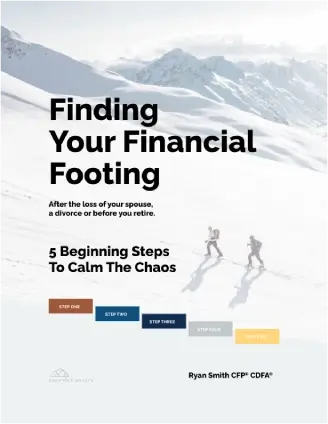It’s completely normal to feel uneasy when headlines scream about market crashes or rallies on the horizon. Social media and 24/7 news can make every dip feel like a catastrophe, fueling the urge to bail out before things get worse. But snap decisions driven by fear often lead to regret once the dust settles. Staying calm and keeping perspective is key to navigating these inevitable waves.
As a financial advisor, I’ve seen firsthand how crucial it is for people to grasp the difference between trying to time the market and simply staying invested. In this post, we’ll look at why it’s so hard to guess market highs and lows, plus practical tips for managing your portfolio—and your nerves—during chaos. My hope is to help you stay confident in a long-term plan rather than letting short-term panic dictate your moves.
Defining “Time in the Market” vs. “Timing the Market”
In my experience as a financial advisor, understanding the difference between these two strategies can make or break an investor’s long-term success. One centers on consistently staying invested, while the other tries to pinpoint “ideal” moments to buy and sell.
Time in the Market
Time in the Market involves remaining invested through various market cycles and accepting that short-term bumps are a normal part of the journey. This approach is rooted in the historical tendency of markets to trend upward over time, allowing investors to potentially capture rebounds and gains without having to guess when they might occur.
A key advantage of staying invested is the power of compounding interest. By reinvesting dividends and maintaining your positions across bull and bear markets alike, you give your portfolio the chance to grow steadily, year after year, rather than risking missed opportunities from sitting on the sidelines.
Timing the Market
Timing the Market aims to buy right before an upswing and sell just ahead of a downturn, but this strategy often collides with common fallacies. For example, the belief that recent trends will continue indefinitely (recency bias) or that short-term market indicators provide foolproof signals to enter or exit can lead investors astray.
Another trap is the illusion of control, where people feel they can outsmart the market based on limited data or “gut feelings.” When combined, these errors in judgment may cause investors to move in and out of positions at the wrong times, ultimately undermining the potential benefits that long-term compounding can deliver.
Please Note: If you’d like to dive deeper into the psychological side of market swings, including how herd mentality influences decisions at different points, feel free to check out this piece on the Psychology Of A Market Cycle.
Historical Evidence: Market Crashes and Recoveries
Market turbulence and talk of financial doom have been part of investing for generations. Despite recurring headlines predicting the “final” crash, time has shown that markets tend to recover—even if the path is steep. By reviewing how deeply markets fell in past crises and noting how long recoveries took, investors gain a sense of perspective.
Consider the following financial “doomsdays” of the past:
Black Monday (1987)
On October 19, 1987, the Dow Jones Industrial Average fell 22.6% in a single day, igniting fears of another Great Depression. Investors faced an alarming collapse in market value that tested everyone’s risk tolerance. Yet despite this massive one-day loss, markets recovered the bulk of their decline within about two years, surprising many who expected a prolonged downturn.1
Dot-Com Bubble (2000–2002)
A surge in internet-driven stocks propelled a speculative frenzy that eventually imploded, with the Nasdaq Composite losing over 75% of its value. Companies with little to no earnings had been trading at exorbitant valuations, a cautionary tale of overexuberance. It took 15 years for the Nasdaq to reclaim its highest value.2r these approaches to save money during retirement:
Great Recession (2008–2009)
Triggered by a housing market collapse and a global credit crunch, the S&P 500 sank approximately 57% from its high. Financial institutions toppled, consumer confidence plummeted, and ordinary investors saw portfolios shrink at a troubling pace. While the crisis spurred unprecedented government interventions, many still questioned whether markets would ever fully recover. By early 2013, however, the S&P 500 had climbed back to pre-crisis levels.3
Pandemic Crash (2020)
In early 2020, the sudden spread of COVID-19 sparked global lockdowns and a swift downturn, with the S&P 500 tumbling about 34% in just over a month. Investors worried that the health crisis would morph into a protracted economic disaster. Despite dire forecasts, markets staged a rapid recovery and regained their losses by August, just five months later. This stark rebound showed how even in the face of unprecedented uncertainty, markets can adapt and recover faster than many anticipate.4
Please Note: I’m not trying to downplay the severity of these events. The purpose of this is simply to illustrate how resilient the overall market has been even after some really rough times. Unfortunately, panicking during these moments can turn a temporary financial crisis into a permanent one.
The Psychological and Behavioral Side
The process of deciding whether to exit or hold tight involves more than raw math. While history is helpful, your mindset, emotional reactions, and instincts all still play a powerful role in shaping how you respond to sudden market swings.
In addition to market history, consider the following:
Anchoring Bias: Investors sometimes fixate on a particular price level or a recent high-water mark and judge all future performance against it. When markets swing, this bias can cause you to cling to outdated expectations or assume that a former price is the “true” value. Overlooking new information and broader trends can lead to misguided decisions about when to buy, hold, or sell.
Overconfidence: Periods of market fluctuation can encourage the belief that you can “outsmart” the crowd, especially if past trades were successful. This overconfidence makes it easier to rationalize risky moves or downplay the need for diversification. In a volatile environment, such self-assurance can turn a promising strategy into a precarious one if the market moves against you.
“Fight or Flight” Reaction: When fear takes over, it’s natural to want to do something—anything—to alleviate anxiety. For investors, this can mean abandoning a carefully crafted plan just to feel back in control. Reacting impulsively may reduce short-term stress, but it often has long-term consequences if you lock in losses or miss out on a rebound.
Please Note: These are just some of the psychological and behavioral patterns that can hurt you during volatile markets. If you’re curious to dive more into common investing fallacies, check out the piece I developed on the 9 Behavioral Biases In Investment Decision-Making.
The Cost of Missing the Best Days
One common theme in market research is how a few really strong days can significantly boost your overall returns. Missing even a handful of these days can result in much lower growth than you would have seen by simply sticking to your strategy. Some of the most powerful rebounds tend to happen shortly after dramatic declines, which makes them easy to miss if you have already sold and are waiting on the sidelines.
If you exit the market when everything looks shaky, you run the risk of being out just when it makes its next big leap upward. Volatility can be uncomfortable, but remember that the best days often appear right after some of the worst.
By panic selling, you can turn what might have been a temporary market setback into a permanent loss. Once you lock in losses and reduce your capital, you have less to reinvest when the market eventually recovers.
Practical Strategies to Stay Invested (While Managing Risk)
We’ve discussed plenty of pitfalls to steer clear of, but that’s only half the story. It’s equally crucial to focus on proactive steps that channel your energy into constructive strategies and help you stay grounded during turbulent times.
To keep your sanity during volatile markets, consider the following:
Adopting a Long-Term Perspective: A broader view looks beyond next week or next month and instead aims for steady progress measured in years (if not decades). That mindset can give you the patience to ride out short-term events without losing sight of what you are trying to achieve over time. This will help you create a better, more resilient plan right from the start.
Diversification Across Asset Classes: Putting all of your money into a single stock or sector can amplify gains but also magnify losses if that one area falls. Distributing your money among different investment vehicles can lessen the blow from any single downturn, reducing the likelihood that one unfortunate market move will topple your entire strategy. This approach can involve domestic and international equities, bonds, and even forms of real estate or other assets.
Dollar-Cost Averaging for Consistency: When you commit to adding a set amount of money into your portfolio at regular intervals, you may buy fewer shares when prices are high and more shares when prices are low. This practice is known as dollar-cost averaging, and it can lessen the stress of deciding exactly when to buy. Over time, it can even out the impact of price swings and remove the temptation to try and time things.
Periodic Rebalancing to Maintain Targets: After a strong upswing or downswing in one asset class, your portfolio could become heavier in one category than you intended. By rebalancing, you bring the holdings back in line with your original goals. This can mean selling some of the winners and purchasing more of the laggards, which can feel strange in the moment, but it is a way to preserve your chosen mix of investments.
Professional Advice and Objective Planning: A financial advisor can help you devise a personalized plan that fits your age, financial objectives, and risk tolerance. They can also offer a calmer viewpoint when markets lurch in unexpected directions, reminding you that a focus on long-range goals tends to matter more than moment-to-moment shifts. Working alongside someone knowledgeable can help keep you from reacting impulsively.
Addressing Sequence of Returns Risk
While I may be a fan of staying in the market, not everyone is at the same stage of life. It may feel somewhat easier to say “Stick with the plan!” when you have plenty of time before retirement. If you are closer to your golden years, however, it’s important to understand sequence of returns risk and how to address it.
Definition and Why Timing Matters for Retirees
Sequence of returns risk refers to how the timing and order of your investment returns can significantly affect your financial outcome—especially for retirees who are already drawing down their portfolios. If you experience a sharp market drop early in retirement and need to sell assets at depressed prices to cover living expenses, you lock in those losses.
With a smaller remaining balance, any subsequent upswing in the market may not fully replenish what you sold during the downturn. As a result, even if long-term average returns look favorable, an early drop can have an outsized impact because you have less time—and less capital—to recoup losses and grow your portfolio over the remainder of your retirement years.
Impact of Early Negative Returns
Suppose someone retires and experiences a market drop in their first couple of years. If their assets shrink and they continue withdrawing the same amount of money, they might be taking a bigger portion of their portfolio at a time when gains have not yet offset the initial drop. This can turn a temporary market dip into a bigger problem over time.
Asset Allocation and Withdrawal Strategies
Handling sequence of returns risk can require a more technical approach. A solid strategy often involves segmenting your portfolio based on when you will need the funds.
Here’s how you might protect yourself:
Short-Term Bucket (0–3 years): Keep enough in cash or cash equivalents to cover near-term living expenses and emergencies. This helps you avoid selling equities when prices are down.
Intermediate Bucket (3–7 years): Invest moderately in less volatile assets like bonds or balanced funds, aiming for some growth with lower risk than aggressive equities.
Long-Term Bucket (7+ years): Maintain more aggressive growth investments here—such as high-quality equities—that you do not plan to touch until much later in retirement. Over a longer horizon, these have more time to recover from market downturns and potentially produce higher returns.
By structuring withdrawals to come first from the short-term and intermediate buckets, you give your long-term growth positions time to rebound if there’s a market decline. This layered or “bucketed” approach can help steady your income stream when markets get choppy, offering a more dependable cushion over the long term.
Don’t Weather The Storms Alone
Two investors can hold the same exact set of stocks but end up with different results if one remains steady through turbulence while the other tries to dodge every dip. Focusing on the power of a long timeline can mean building more confidence in your ability to weather market storms. This outlook highlights the importance of seeking growth potential without constantly second-guessing every bump in the road.
Your investment style should match your stage in life. If retirement is still far off, you might tolerate bigger dips. If you need income soon, you might adjust your strategy to protect against extreme fluctuations. In any case, the principle of prolonging your exposure to quality investments remains central to steady growth.
If you are uncertain about how to adapt these ideas to your personal plans, consulting a professional can supply tailored ideas that align with your goals. Their input can help you balance your desire for growth with the realities of your personal finances. As a CERTIFIED FINANCIAL PLANNER® professional, I’ve been helping people navigate volatile markets for over 13 years. If you’d like to speak with a financial thinking partner, use the button below to schedule sometime with me!
We offer a free consultation called…
The Financial Transition Strategy™
It’s designed to help you quiet the noise and create a clear path forward, as well as help you get to know us and see if we’d be a good fit to work together.
We’re always respectful, and there’s never any pressure.
Securities and advisory services offered through Commonwealth Financial Network®, Member FINRA/SIPC, a Registered Investment Advisor. Fixed insurance products and services not offered through Commonwealth Financial Network®.
Diversification does not assure a profit or protect against loss in declining markets, and diversification cannot guarantee that any objective or goal will be achieved.
Dollar cost averaging is a systematic investment plan that involves continuous investment, regardless of market conditions. Markets will fluctuate, and clients must consider their ability to continue investing during periods of low price levels. Systematic investment plans do not assure a profit or protect against loss in declining markets.
Resources:
- https://www.bankrate.com/investing/biggest-stock-market-crashes-in-us-history/#1929
- https://www.investopedia.com/terms/d/dotcom-bubble.asp
- https://www.nasdaq.com/articles/a-short-history-of-the-great-recession
- https://www.cnbc.com/2021/03/16/one-year-ago-stocks-dropped-12percent-in-a-single-day-what-investors-have-learned-since-then.html


